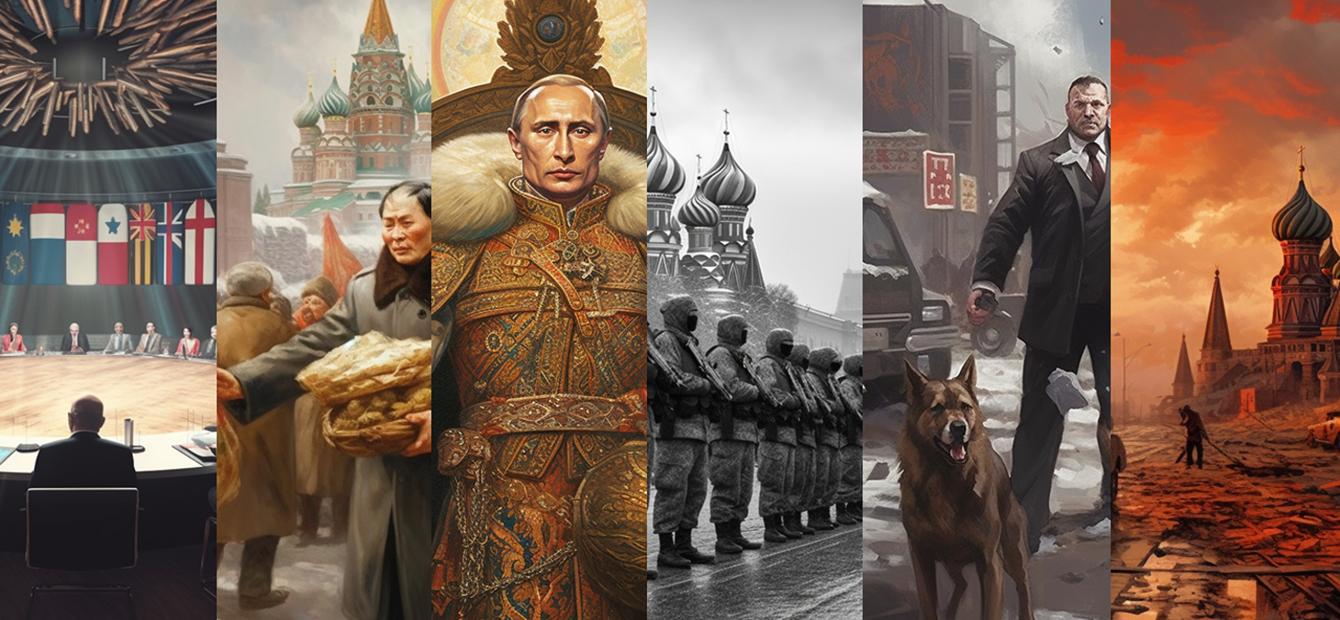
How the war might change Russia: 6 possible futures
Russia’s invasion of Ukraine has an enormous impact on the current and future security of Europe. This Clingendael Spectator series analyses how Europe’s relation with Ukraine and Russia will be affected. In the third episode, Clingendael experts Niels Drost and Bob Deen explore what Russia might look like in the future.
While the Russian invasion of Ukraine is truly existential for Ukraine, its outcome will also profoundly shape the future of the Russian Federation – and vice versa. So far, hundreds of thousands of Russians have either died or been injured on the battlefield in Ukraine1 and even more have fled the country to avoid repression or mobilisation. The Russian economy and state budget are under pressure, repression and militarisation have risen to a new high in modern Russia, crime is rampant, and demographic pressures are mounting.
It is increasingly unlikely that this war will truly end while the current regime remains in power
The invasion has turned into a long war of attrition with no clear end in sight. For now, Vladimir Putin appears to be doubling down on this devastating war and is waiting for the West to back off and abandon Ukraine. In his December press conference, he remained defiant: “There will be peace when we achieve our goals”, gleefully capitalising on uncertainty over continued US and European support to Ukraine.2 But the Kremlin appears to lack a plan to get Russia out of the corner it has painted itself in. The response of Russian Defence Minister Sergei Shoigu, when he was asked if Russia will win, is telling for this situation: he merely shrugged and said, “what choice do we have?”3
It is increasingly unlikely that this war will truly end while the current regime remains in power. This article therefore explores six pathways for its potential futures and the implications they hold for Western policymakers.
The scenarios in this article are based on the recent Clingendael report 'After Putin, the deluge?' To help policymakers prepare for what might lie ahead, the authors have drawn up a model consisting of 35 variables that together will shape the future of Russia – based on an extensive literature review and scenario workshop with 16 Dutch and international experts. They then built on this model to construct a scenario framework for the next 5 years, taking into account the stability of the Russian regime and the degree of international isolation of Russia.
Scenario 1: Regime continuity

In the first scenario, Russia has lost the war in Ukraine. Due to increasingly humiliating battlefield defeats, a sharp economic downturn, and growing domestic discontent, various groups in the Russian elite join forces to oust Putin. The new president signs a temporary armistice with Ukraine under which it agrees to cease active hostilities and retreat from the Ukrainian mainland, strikes a deal with the West, makes Putin and his loyalists the scapegoat, and enacts limited democratic and economic reforms.
This scenario is particularly probable if the Russian invasion of Ukraine is unsuccessful, as a new Russian leadership will have a strong interest to triage the conflict and secure better relations with the West – which it will try to do so for the least concessions possible. Although the new leadership distances itself from Putinism, it does not entirely reject Russia’s imperial past or authoritarian style of governance – nor its strategic interests in retaining influence in its ‘near abroad’.
With a new president leading the new Russian government while continuing some of Putin’s policies, the central policy dilemma for the EU in this scenario is to which extent and under which conditions any form of reconciliation and normalisation of relations can be achieved with a new Russian leadership. Should this include a full withdrawal from Ukraine, arms control, accountability, reparations, ‘de-Putinisation’, or all of the aforementioned… and more?Bovenkant formulier
Scenario 2: China’s propped-up proxy

In the second scenario, the war grinds on for years and no end is in sight. Putin eventually steps down, but the regime itself prevails and a successor secures political and financial backing from Beijing. Russia becomes fully dependent on China, for which it serves multiple useful purposes: as a stable supplier of cheap natural resources and as a distraction for the US and Europe. Emboldened by Chinese support, Russia remains both confrontational towards and isolated from the West.
This seems to be one of the more probable outcomes that have been identified; it represents a continuation of the current trend, in which Russia keeps fighting and steadily becomes more dependent on China. While it is quite possible that this scenario unfolds while Putin is still in control, it is important for policymakers to prepare for a variant in which Putin is no longer in power.
As the relationship between Putin and Xi Jinping is highly personalised and there might be some disappointment and resistance at other levels within the Russian elite, this could lead to more uncertainty about the future of the relationship. Some Russians might prefer to reach some kind of agreement with the West rather than becoming completely dependent on Beijing.
In this scenario, the EU’s primary dilemma is how to cope not only with a long war, but also with Russia becoming a tool for Beijing that serves Chinese interests in light of broader geopolitical competition between the US and China.
Scenario 3: The Empire strikes back

In the third scenario, Russia decisively wins the war after Western support for Ukraine dwindles. Putin’s popularity surges and his domestic and international position is strengthened. Russia secures international partners to sustain its economy, while the unity of the West falters. Although relations with the West remain tense, Russia manages to establish sufficient new economic and military partnerships, reinvigorating its economy and reinforcing and expanding its military. Despite Putin’s age, his personal stature as a historic figure enables the regime to persist in governance.
Meanwhile, a fragmented and weakened West faces an increasingly assertive Russia and China. With an emboldened and rearmed Russia right on its doorstep, the EU and NATO will need to invest considerable resources to bolster its defence capabilities to deter future Russian aggression – especially if the United States embarks on a more isolationist course.
Europe will also have to come to terms with a destroyed, impoverished, and vengeful Ukraine that will continue to try to resist Russia – and blames the West for abandoning it. This sense of betrayal will also resonate profoundly within the EU and NATO, especially among Central and Eastern European countries.
While this scenario at present still seems relatively improbable in comparison to the other scenarios, it can by no means be ruled out and its impact would be very high. It particularly serves as a stark reminder of why the West supports Ukraine: not only to help the country in defending its sovereignty against Russian aggression, but also to uphold the rules-based order, deter future military aggression, and preserve the unity of the Transatlantic alliance.
Scenario 4: Neo-Stalinist fortress Russia

In the fourth scenario, Putin has turned Russia into a global pariah due to more and more atrocities in Ukraine or perhaps even the use of weapons of mass destruction. Countries like China and India abandon their tacit support, forcing Russia to become largely self-sufficient. The regime continues its reign through brutal repression and propaganda, adopting a Stalinist approach and suppressing any form of protest or unpatriotic disobedience. Russian foreign policy continues its trends of paranoia, hostility and ‘active measures’ towards the West while increasingly focusing on achieving autarky.
Although this low-probability but high-impact scenario would not be considered very plausible by most experts, especially concerning the use of nuclear weapons, a much more isolated Russia remains a distinct possibility. Making Russia a global ‘pariah state’ aligns with Ukraine’s policy preferences, presumably as an intermediate step before regime change. Western attempts to diplomatically and economically isolate Russia also point at this scenario as a preferred outcome, at least for the short term. It even opens up possibilities for China and the West to cooperate in attempting to solve “the Russia question”. The dilemma for the West is rather how to achieve this outcome, as the current trend appears to head in the inverse direction: Russia is becoming less internationally isolated, not more.
Scenario 5: The Wild East

In the fifth scenario, Putin’s regime loses legitimacy after continued humiliation and a defeat on the battlefield. Russia withdraws from the south and east of Ukraine, the power structure begins to crumble, and the country descends into a degree of ‘organised chaos’ with high levels of criminality. The Russian Federation manages to preserve its territorial integrity, but Moscow must cede a degree of power and autonomy to regional strongmen in order to keep the country together.
Longer-running socioeconomic problems come to the forefront due to the destructive consequences of the war and the weakened repressive apparatus of the state, including the phenomenon of brain drain. China does not actively support Moscow; instead, it ruthlessly exploits the situation. The new Russian leadership does not pursue reconciliation with the West or Ukraine but also refrains from further aggression towards its neighbours – not because of a lack of will, but rather due to a lack of capacity.
This scenario has a relatively high probability, and some experts in Ukraine or Eastern Europe may even consider it a relatively desirable scenario. However, it is certainly not a stable outcome. ‘The Wild East’ is reminiscent of the Russian state of the 1990s: an unpredictable, unruly place that might not directly threaten its neighbours through military aggression or energy blackmail, but that nonetheless poses significant problems due to transnational organised crime, irregular migration, and other knock-on effects of regional instability.
6. Dissolution without a nuclear solution

In the sixth – and last – scenario, a catastrophic military defeat leads to the implosion of the Russian Federation. A general sense of deep resentment against the central government spreads across the elites. The Russian economy is on the edge of meltdown. The disastrous consequences of the war, the high number of human losses, and long-standing social issues give rise to social unrest.
The elite and security forces begin to fight among themselves, and large-scale protests break out across Russia. Regional elites contest the way in which the Russian Federation is governed and demand decentralisation and territorial autonomy. Military attempts to quell these separatist movements result in armed conflict across Russia for a number of years. As the Russian military fractures, regional warlords swiftly seize nuclear assets and use them to deter the Kremlin in the rump state of Muscovy, which eventually must acquiesce to the new reality.
This scenario is a quintessential low-probability, high-impact scenario. Most analysts agree that although centrifugal forces are at play inside the Russian Federation, the centripetal forces binding it together remain more potent. These forces include the common interest of a majority of the elite and the population to avoid the instability and loss of power and revenue associated with this scenario.
That does not mean it is impossible. If such a scenario materialises, the West will have only a short window of time to react to a rapidly unfolding series of events, with limited possibilities to shape the outcome. It will face a broad range of urgent and complex questions such as how to secure Russia’s nuclear arsenal; whether to recognise breakaway republics and whether to defend them from aggression by the rump state of Muscovy; and how to cope with the inevitable influx of refugees from destructive conflicts that may erupt across the territory of the former Russian Federation.
Implications for the EU
Although the full-scale invasion itself started less than two years ago, it will soon be ten years since Russia annexed the Crimean peninsula and began its military aggression against Ukraine. As the war will grind on into 2024, and possibly well beyond that, Russia and the West both appear to be waiting each other out at Ukraine’s expense.
The Kremlin clearly hopes that Western support will dwindle and that Ukraine will eventually collapse due to military, economic, and demographic pressure. Conversely, the West appears to hope that the same will happen to Russia, even though it lacks a clear vision on what happens next and what kind of Russia it might have to deal with afterwards.4
However, hope cannot be a policy when it comes to Russia. The EU, as well as NATO, needs to think ahead, have debates about which scenario’s would be preferable, and make policy accordingly to increase the possibilities of these desired outcomes.
Merely waiting and hoping for better days that might never come is not a particularly prudent policy
This becomes especially crucial due to differing opinions between Western European and Eastern European members of the Union. In Western Europe, an unstable or potentially fragmented Russia is primarily considered to be a security risk. In Eastern Europe (including Ukraine), on the other hand, an unstable Russia is seen as a mitigating factor, diminishing the historical security threat posed by Russia.
If the EU aims to prevent an ‘Empire strikes back’ scenario from coming true, in which a powerful Russia decisively wins the war, then support for Ukraine must not only persist but also significantly increase. Simultaneously, a stark increase in support for Ukraine could also lead to an increasingly unstable and isolated Russia. In such a scenario, the Russian Federation is either too weak to further pose a direct military threat to its neighbours, as in the ‘Wild East’ scenario, or it potentially even collapses and seizes to exist in a ‘dissolution without a nuclear solution’.
Merely waiting and hoping for better days that might never come is not a particularly prudent policy, especially not when the price for inaction is paid first and foremost by Ukraine.
- 1Neither side releases reliable data on the number of casualties, but it is clear that the losses are high. Western sources estimate the number of Russian casualties as of mid-August 2023 at around 300.000, including 120.000 killed and 170-180.000 wounded. See: Helene Cooper, Thomas Gibbons-Neff, Eric Schmitt and Julian E. Barnes, ‘Troop Deaths and Injuries in Ukraine War Near 500,000, U.S. Officials Say’, The New York Times, 18 August 2023.
- 2Vladimir Putin, ‘Results of the Year with Vladimir Putin’, President of Russia, 14 December 2023.
- 3Russia 1, ‘Will we win? We do not have other options! - Shoigu commented on the situation at the front’, Dzhen, September 2023.
- 4Richard D. Hooker, Jr., ‘2024 preview: The West must decide if it wants Ukraine to win’, Atlantic Council, 17 December 2023.








3 Comments
Load comments
Russia
De zes scenarios zijn weldoordacht, maar er dient een mogelijke ontwikkeling te worden toegevoegd. Indien de militaire hulp van Navo landen aan Oekraïne groeit en Rusland grote verliezen dreigt te lijden, zou Moskou slagveld- kernwapens kunnen inzetten. Hoe dan te reageren? De VS moet daarin de leiding nemen. Een mogelijk antwoord is dan niet nucleair te reageren maar militair relevante objecten in Rusland met niet-nucleaire precisiewapens te vernietigen. Dat zou tot gevolg kunnen hebben dat Rusland als mogendheid flink aan macht inboet en delen ervan het voorbeeld van Oekraïne kunnen gaan volgen. De dekolonisatie van Moskou's imperium, wat in jullie scenario's is opgenomen.
insightful scenario examination
Thank you for this article, especially the following paragraph, which clarifies the enduring divide between Western and Eastern Europe and the main obstacle to permanently securing sovereignty for all European nations: "This becomes especially crucial due to differing opinions between Western European and Eastern European members of the Union. In Western Europe, an unstable or potentially fragmented Russia is primarily considered a security risk. In Eastern Europe (including Ukraine), on the other hand, an unstable Russia is seen as a mitigating factor, diminishing the historical security threat posed by Russia". On a tangentially related note, some might be interested in an article I came across on Phys.org outlining how human evolution opposes globally coordinated solutions to complex problems (phys.org/news/2024-01-evolution-humans-climate.html). The study outlined in the article specifically focuses on the issue of climate change, but the insights can be more universally applied to any transregional or complex global issue that requires collective cooperation between nations to act beyond their own national and regional interests (in order to also secure those interests in the long run).
Redline
It's al started when the war criminal Bush wanted to cross the Russian redline of welkoming Ukraine and Georgia in Nato (2008 Boekarest meeting)
Add new comment